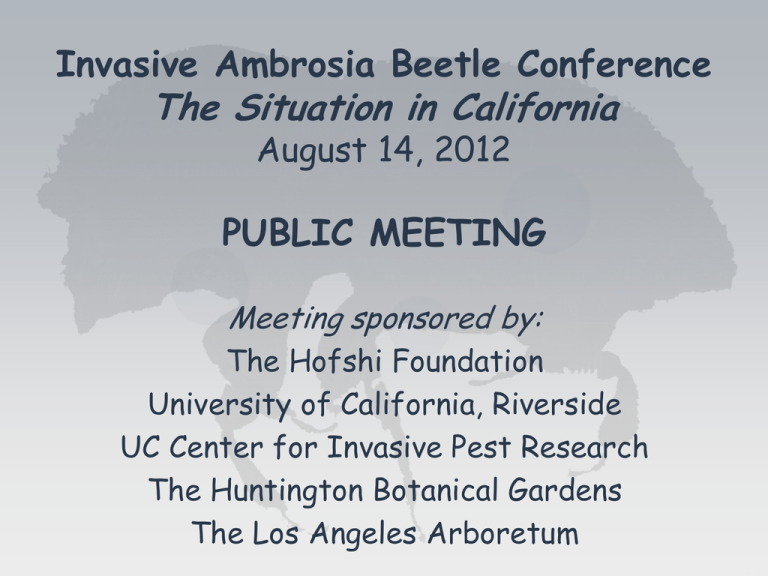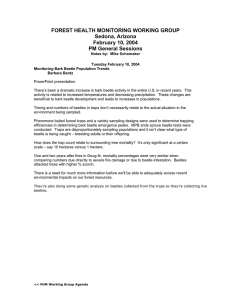The Situation in California Invasive Ambrosia Beetle Conference PUBLIC MEETING
advertisement

Invasive Ambrosia Beetle Conference The Situation in California August 14, 2012 PUBLIC MEETING Meeting sponsored by: The Hofshi Foundation University of California, Riverside UC Center for Invasive Pest Research The Huntington Botanical Gardens The Los Angeles Arboretum What is the problem? R. Stouthamer, P. Rugman‐Jones, A. Eskalen, A. Gonzalez Department of Entomology & Department of Plant Pathology and Microbiology University of California, Riverside This is the problem + Ambrosia beetle Fungus (=ambrosia) Dead Tree Tea Shot hole borer (Euwallacea fornicatus) Male Female Life cycle beetle • Mated female bores into tree, creates galleries in tree, in the region that transports the water from the roots to the leaves • Galleries are infected with symbiotic fungus (= ambrosia in this case a new Fusarium species) that beetle carries in mouth parts • Fungus grows on gallery walls and spreads through the tree Life cycle beetle • Mated female bores into tree, creates galleries in tree, in the region that transports the water from the roots to the leaves • Galleries are infected with symbiotic fungus (new Fusarium species) that beetle carries in mouth parts • Fungus grows on gallery walls and spreads through the tree • Female lays eggs in galleries • Eggs hatch and larvae feed on the fungus • New adults after about one month • Sex ratio offspring very female biased, brothers mate with sisters in galleries (fornicatus) and mated females leave the galleries to create their own galleries for offspring production • Lifestyle leaves very few ways to combat the beetle. Single mated female can initiate new population Euwallaecea fornicatus • First detected in CA in 2003 in Whittier Narrows • Since then caught a couple of times in CDFA traps in LA County • Caused death of large number of Box Elder street trees in Long Beach in 2010 • Problem not recognized until February 2012 when Akif Eskalen found it on a backyard avocado in South Gate • Since then surveys have shown that – Widely spread in LA Co. and parts of Orange Co. – Attacks many host tree species Euwallacea fornicatus • Where does the beetle come from? – Probably South East Asia, possibly Africa – Also an invasive species in Israel causing extensive damage to Avocado • Beetle identity – Morphologically E. fornicatus – Based on DNA evidence it is another as yet unnamed species – Suggested common name Polyphagous Shot Hole Borer What happens when beetle attacks a tree? • Appears to try out many different tree species, about 47% of the 110 common street tree species (52 species) in S. Cal. • Outcome of attack: – Beetle is repelled, no fungus infection (20 species) – Beetle drills into the tree, transmits fungus to the tree but does not produce offspring on the tree (29 species) – Beetle is not repelled, fungus infects tree, beetle reproduces in tree (true host) at least 4 species Beetle is repelled, no fungus infection Beetle drills into the tree, transmits fungus to the tree but does not produce offspring on the tree • We do not know the final outcome of this interaction – Often leakage of xylem fluid noticed on trunk and branches: can the tree leak to death? – Could still mean that the tree will suffer if the xylem vessels are clogged up and this will cause dieback of branches – Maybe nothing bad will happen to tree Beetle is not repelled, fungus infects tree, beetle reproduces in tree (true host) • These trees suffer • Mild symptoms will be branch dieback, severe symptoms tree death. • Known hosts: – Castor bean – Box elder – Coast life oak – Avocado Host species Box Elder Box Alder (Acer negundo) Host species Box Elder Box Alder (Acer negundo) Host species Coast live oak (Quercus agrifolia) Host species avocado (cv. Hass) Conclusion • New invasive ambrosia beetle • Tries out many different trees (~50% of all tree species) • Infects some of these trees with fungus (~60% of attacked tree species) • Beetle reproduces in ~ 8% of attacked tree species • Avocado, Coastal life oak, Box elder • Fungus infection and beetle reproduction can cause dieback of tree branches and death of trees • We know little about the outcome of only fungus infection • No known methods to control the beetle or fungus infection once it is in tree • Looks to be a major problem in urban forest, commercial avocado and forests once it gets there. Funding and Collaborators Funding: California Avocado Commission Collaborators: Reuben Hofshi, Hosfhi Foundation Mary Lu Arpaia, UC Riverside Tim Thibault, Huntington Botanical Garden Frank McDonough, LA Arboretum Gevork Arakelian, County Ag. Commissioner in LA Tom Coleman, Forest Service, Southern California






